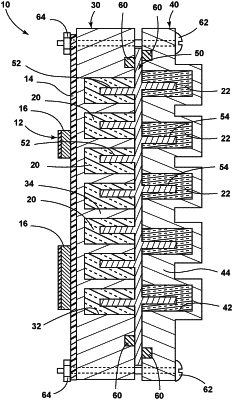| CPC H05K 7/2029 (2013.01) [H01L 23/4275 (2013.01); H05K 7/20509 (2013.01); H01L 2924/0002 (2013.01)] | 17 Claims |

|
1. A heat sink assembly for use with at least one heat-emitting component, comprising:
a first phase change material conductively coupled to the at least one heat-emitting component and changing phase at a first temperature;
a first frame defining a first number of first chambers formed by first walls extending from a first side;
the first phase change material disposed in the first chambers;
a second frame defining a second number of second chambers formed by second walls extending from a second side facing the first side, wherein the second number is different from the first number;
a second phase change material disposed in the second chambers, conductively coupled to the first phase change material and changing phase at a second temperature, which is greater than the first temperature; and
a separate intermediate structure located between the first frame and the second frame wherein the intermediate structure is an intermediate heat-conducting structure comprising a plate and a first set of fins cantilevered from the plate extending in a first direction into respective ones of the first chambers, and a second set of fins cantilevered from the plate and extending in a second direction into respective ones of the second chambers, the first direction being opposite the second direction;
wherein the first phase change material changes phase in response to a conductive transfer of heat from the at least one heat-emitting component and the second phase change material changes phase in response to a conductive transfer of heat from the first phase change material.
|